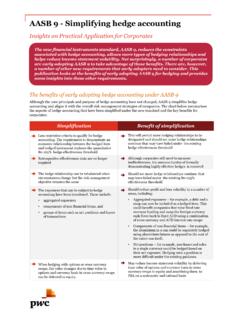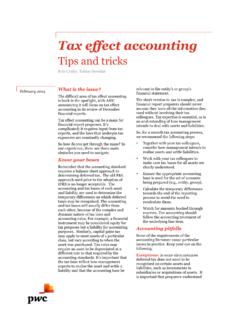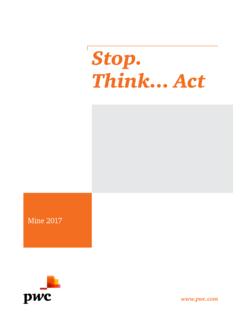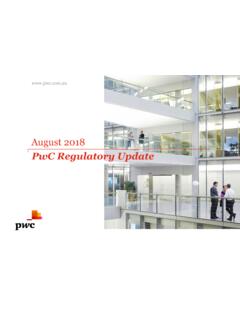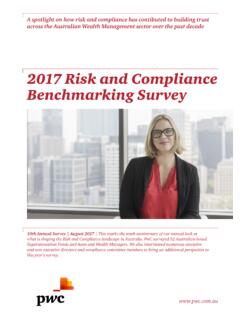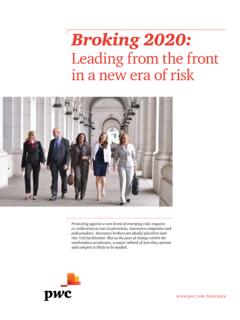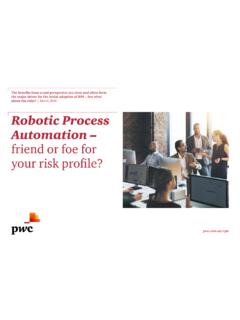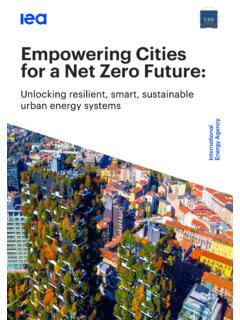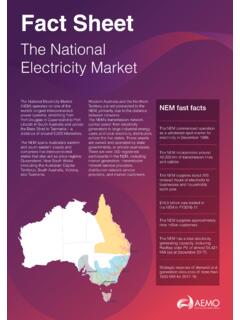Transcription of Essential 8 Emerging Technologies ... - PwC Australia
1 Governance Insights CenterTechnology seriesEmerging technologiesThe Essential Eight technologiesBoard byte: artificial intelligence Artificial intelligence is changing how companies do business. What should boards know? Companies across industries are using, investing in or planning to invest in artificial intelligence (AI). AI is improving industry processes and making machines smart. It is expected to be one of the most disruptive Technologies impacting industry and business. As the market for AI grows, boards should understand how this technology will affect their company s byte: artificial intelligence We ve all heard of artificial intelligence (AI). It s in the movies and is now in our everyday lives at home and work. AI is more than just a single independent technology. It s making smart devices smarter, data more valuable and cloud-based tools more efficient. It s turning autonomous vehicles into reality. It will disrupt business models, create new ways of working and facilitate digital transformation.
2 In the not-so-distant future , most technology applications will likely incorporate or harness the output of some form of artificial intelligence. So what is it, exactly? In a nutshell, AI enables computers and other devices to perceive, analyze and adapt to their environments. Using software algorithms, these devices can perform tasks that would normally require human intelligence. AI enables machines to sense their environments, think, learn and respond on their own, becoming increasingly autonomous. In effect, AI allows machines to contribute more intelligently to business activities. They do this by recognizing and interpreting digitized text, sound and images, making it possible to answer questions, suggest solutions and diagnose problems or take actions. As a result, AI can reduce the amount of rote work humans are faced with everyday. PwC Governance Insights CenterTechnology seriesAI is wide-ranging AI is an umbrella term for smart Technologies that are aware of and can learn from their environments.
3 Robotic process automation (RPA), machine learning, natural language processing and neural networks all incorporate AI into their operations. What are they? RPA software automates repetitive business, industrial and other tasks. RPA can help users in the back office optimize their processes. Machine learning allows computer systems to learn from data and recognize patterns, predict outcomes, assist humans with understanding or suggest actions (becoming smart ) without being explicitly programmed. Among other things, machine learning can inform decision-making and make process automation more Natural language processing (NLP) interprets aspects of natural spoken language or text in order to provide insights or enable functions. NLP allows computer systems to analyze and understand the human language. Neural networks are interconnected networks of artificial neurons, or nodes, that simulate human brain cells. They re designed to learn from labeled patterns in data that flow through the network layer by layer.
4 They record what they learn by weighting or unweighting an input to determine how correct or incorrect it is with the ultimate goal of using probability to solve the task being performed. Deep learning is machine learning using several hidden layers of neural networks. Just as electricity is fundamental to the way we live, in the not-so-distant future , it is not hard to see how AI will become the new electricity embedded and/or supporting just about every aspect of our life. Daniel Eckert, PwC's Emerging Tech Leader 3 Board byte: artificial intelligence PwC Governance Insights CenterTechnology seriesAfter analyzing more than 150 Emerging Technologies , PwC categorized AI as one of its Essential Eight Technologies . AI is transforming all industries. In fact, CEOs agree that AI will impact every facet of business, offering unprecedented ways to innovate and grow companies in nearly every industry. And the market for AI is growing fast. In 2016, the AI market attracted more than $3 billion in venture The total projected market is expected to reach $70 billion by According to PwC s 2017 Global Digital IQ Survey, the number of companies that are investing or have plans to invest in AI is second only to those investing in the internet of things (IoT).
5 So why are companies investing in this technology? Companies are looking at AI as a means to foster innovation, optimize business efficiency and improve productivity. AI also enables other Emerging Technologies , like robots and the IoT, and it can improve data analytics. AI: the future of everything?Industrial Products59%AutomotiveRetail & ConsumerHealthcareTechnology, Media & TelecommEnergy & MiningPower & UtilitiesPublicSectorHospitality & Leisure51%56%58%58%Financial Services66%67%68%74%80%Artifical intelligence investment in three years by industrySource: PwC, 2017 Global Digital IQ Survey . Bases: Automotive: 72; Energy & Mining: 135; Financial Services: 332; Healthcare: 237; Hospitality & Leisure: 75; Industrial Products: 375; Power & Utilities: 131; Public Sector: 156; Retail & Consumer: 217; Technology, Media & Telecommunications: 43372% of business leaders believe AI will be the business advantage of the future . PwC, 20th Global CEO Survey, 20174 Board byte: artificial intelligence PwC Governance Insights CenterTechnology series Jeeves goes digital Digital assistants AI programs that help people get answers to questions and perform tasks and services are most commonly used at home, through mobile devices or computers.
6 They can interpret language to search vast amounts of information for answers to questions, make changes to your calendar and even control some household appliances and smart home devices with verbal commands part of the IoT. Forty-two percent of consumers already use them, and 72% of business executives What else is coming? AI assistants as tutors, travel agents and tax preparers. Never forget a face Uploading your pictures to social media and tagging your friends? Often, their names pop right up, thanks to AI. But there s more to facial recognition technology today than what you see on Facebook. Companies in the advertising, security and automotive industries are using image recognition, machine learning and deep learning to better serve customers. The data from an image can help identify customer preferences and offer new suggestions. Its benefits also extend to law enforcement the data can be used to detect suspicious behavior. And it can help Alzheimer s patients and the visually impaired as well.
7 AI in the sky Some researchers are looking to AI to develop a smarter autopilot that does more than fly pre-planned flight paths. The autopilot can learn how to adapt to changing conditions, such as bad weather or engine failure, by studying pilot actions and sorting through flight data. Airlines are also starting to use AI outside of the cockpit for preventative and predictive maintenance, as well as for route management, booking and customer service. AI in action today5 Board byte: artificial intelligence PwC Governance Insights CenterTechnology seriesTransforming healthcare. AI is fast becoming a critical part of the healthcare industry. A vast amount of patient healthcare data has been collected in recent years. With AI, that data can be sorted, organized and interpreted, What s next for AI?helping doctors and nurses make better and more efficient patient care decisions. The healthcare industry can also use AI for diagnostics, for example, to detect small variations within patients health data, compare them to similar patients, and enhance imaging diagnostics in radiology and pathology.
8 AI can also help identify potential pandemics early and track the incidence of diseases to help prevent or contain their is changing the relationship between humans and machines. Leaders across industries are banking on the connection between human and artificial intelligence. AI could process, analyze and evaluate the vast amounts of data generated today, allowing humans to focus on creative high-level thinking. Companies are also thinking about what AI could mean for their workforce. How will AI affect employees? Will it change the kinds of skills we need? How will humans and machines work together? Do we pair our best people with the technology so it can learn from them? Or do we have the technology handle certain tasks while employees focus on others?Four ways to apply AI, from simple to advanced: Automated intelligence is the automation of manual or cognitive tasks and does not involve new ways of doing things ( , software that compares documents and spots inconsistencies and errors).
9 Assisted intelligence improves what people and organizations are doing today, helping people perform tasks better ( , industrial robots, medical image classification, paper check reading and verification by a bank s ATM). Augmented intelligence enables them to do things they otherwise couldn t do and make better decisions ( , Netflix suggesting viewing choices for users based on a customer s patterns of behavior and those of the broader audience, guided personal budgeting). Autonomous intelligence automates the decision-making process without human intervention, establishing machines that act on their own ( , automated trading in stock markets, fully autonomous self-driving cars, full-fledged language translation programs).6 Board byte: artificial intelligence Companies adopting AI expect to see increased productivity. New efficiencies can be derived from streamlining tasks that previously took humans weeks to complete and improving work processes by pairing people and machines in new ways.
10 Many businesses also believe AI will accelerate and enhance innovation, creating new jobs. And some expect to see increased consumer demand from more personalized and higher-quality AI-enhanced products and services. Some worry that AI and automation will end up eliminating jobs. But to capitalize on the technology, companies will need to hire people with AI experience or the skills to analyze and use the data. This talent is in short supply, though, which means securing it could become expensive. Companies also need the computing power and system infrastructure to support AI-enabled products and services, and they need platforms to organize and integrate their data. Getting this infrastructure in place can be costly. The data collected by AI presents another big challenge. How do companies ensure it is valid? What limits do they need to put on its use? Can safeguards ensure that machines carry out human orders as intended? There are concerns that unintended biases may find their way into AI algorithms or decision-making models.
